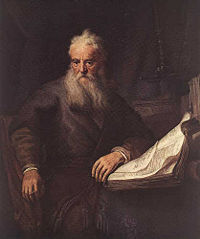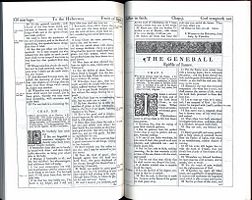Epistle to the Hebrews
| New Testament |
|---|
The Epistle to the Hebrews is one of the books in the New Testament. Though traditionally credited to the Apostle Paul, the letter is anonymous and most modern scholars, both conservative and critical, believe its author was not Paul himself but some other member of his Pauline community.
Authorship

The author of Hebrews is not known. The text as it has been passed down to the present time is internally anonymous, though ancient title headings often attribute it to the Apostle Paul.[1] However, even in antiquity doubts were raised about Paul's alleged authorship.
The reasons for this controversy are fairly plain. All of Paul's other his letters—whether disputed as authentically Pauline or not—contain an introduction stating authorship, yet Hebrews does not. Also, while much of its theology and teachings are considered Pauline, Hebrews contains many other ideas which seem to have no such root or influence. Moreover, the writing style is substantially different from that of Paul's authentic epistles, a characteristic first noticed by Clement of Alexandria (c. 210). In particular, Hebrews claims to have been written by a person who received the Christian message from others,[2] while in his letter to the Galatians Paul forcefully defends his claim that he received his gospel directly from the resurrected Jesus himself.
In response to the doubts raised about Paul's involvement, other possible authors were suggested as early as the third century C.E. Origen (c. 240) suggested that either Luke the Evangelist or Clement of Rome might be the author.[3] Tertullian proposed Paul's companion Barnabas.
Nevertheless, in the fourth century, the church largely agreed to include Hebrews as the fourteenth letter of Paul. Jerome and Augustine of Hippo were influential in affirming Paul's authorship,[4] and the Church affirmed this authorship until the Reformation. Arguing in favor of Paul's authorship are such factors as the letter's basic Pauline theology, many Pauline themes, the use of language very similar or the same as Paul's, and a reference to Paul's frequent companion Timothy in the closing lines.
Martin Luther proposed Apollos—"a learned man" (Acts 18:24), popular in Corinth (1 Cor 1:12), and adept at using the scriptures and arguing for Christianity while "refuting the Jews" (Acts 18:27–28)—as its author. In more recent times, some scholars have advanced a case for the authorship of Hebrews belonging to Priscilla or Silas.
In general, the evidence against Pauline authorship has convinced most scholars that the letter is not by Paul.
Audience and date
Hebrews was written to a an audience facing very specific circumstances:
- The original readers of the letter were conversant in the Septuagint translation of the Old Testament, as the author's usage shows.
- The types of sins listed in chapter 13 suggest they lived in a city.
- They had once faced persecution (10:32–34), but not to the point of shedding blood (12:4).
- Some had stopped assembling together because of persecution (10:25).
- As the author saw it, at least some among them were being tempted to avoid severe persecution by "shrinking back" [10:32-39] from the apostolic witness to Jesus Christ. It is debated whether the anticipated persecution was from secular (i.e., Roman) authorities or Jewish authorities, or both.
- In 13:24 the author says that those from Italy greet the readers, implying this as the place of writing.
The letter's audience is thought to be Jewish Christians. It emphasizes that non-Jewish followers of Jesus do not need to convert to Judaism to share in all of God's promises to Jews.
Hebrews has been dated to shortly after the Pauline epistles were collected and began to circulate, c. 95 C.E.
Style
Hebrews is a very consciously "literary" document. The purity of its Greek was noted by Clement of Alexandria, and Origen asserted that every competent judge must recognize a great difference between this epistle and Paul's (Eusebius, VI, xxv). However, Hebrews does not fit the form of a traditional Hellenistic epistle, lacking a proper prescript. Modern scholars generally believe this book was originally a sermon or homily, although possibly modified after it was delivered to include the travel plans, greetings and closing (13:20-25).[5]
This letter consists of two strands: an expositional or doctrinal strand (1:1–14; 2:5–18; 5:1–14; 6:13–9:28; 13:18–25), and a hortatory or ethical strand which punctuates the exposition parenthetically at key points as warnings to the readers (2:1–4; 3:1–4:16; 6:1–12; 10:1–13:17).
Summary
In the past God spoke through the prophets, but in these "last days," he speaks through his Son, who sits at God's right hand and is even higher than the angels. (Chapter 1) Care must be taken not to "drift away" from the Son, for the teachings of angel, who are merely "ministering spirits" is not binding. Although Jesus became lower than the angels when he lived on earth and suffered death, God has now made all things subject to him. Although Jesus is our savior he is also our brother, for he has made us all one family. He was made like his brothers in every way, suffering not only death but temptation, in order to atone for their sins.(Chapter 2)
As a faithful son of God, Jesus is worthy of even greater honor than Moses. Those who know him must not lose faith and turn back, like those Israelites who rebelled against Moses and wished to return to Egypt. (Chapter 3) God has promised a Sabbath to those who are faithful, and today that promise if fulfilled to those found worthy to enter his "rest." Jesus is the great high priest of the current era, a person who was tempted like all of us yet found without sin, so we may approach God's throne with confidence of His grace.
See also
- Authorship of the Pauline epistles
- Sermon on the Mount#Interpretation
- Antinomianism
- Justification by Faith
- Antilegomena
ReferencesISBN links support NWE through referral fees
- ↑ A number of mss., namely the earliest extant (P46), bear the title of simply, "To the Hebrews," without Paul's name.
- ↑ Heb 2:3–4
- ↑ Eusebius, Church History 6.25.11-14
- ↑ Lane, William L. Hebrews 1-8 (Word Biblical Commentary Vol. 47A. Dallas, TX: Word Books, 1991), Introduction page cliv.
- ↑ Ehrman, Bart D. (2004). The New Testament: A Historical Introduction to the Early Christian Writings. New York: Oxford. ISBN 0-19-515462-2.
Further reading
- Attridge, Harold W. Hebrews. Philadelphia, PA: Fortress Press, 1989.
- Hagen, Kenneth. Hebrews Commenting from Erasmus to Beze. Tubingen: J.C.B. Mohr (Paul Siebeck), 1981.
- Heen, Erik M. and Krey, Philip D.W., eds. Ancient Christian Commentary on Scripture: Hebrews. Downers Grove, IL: Intervarsity Press, 2005.
- Hughes, P.E. A Commentary on the Epistle to the Hebrews. Grand Rapids, MI: William B. Eerdmans Publishing Company, 1977.
- Guthrie, Donald The Letter to the Hebrews. Grand Rapids, MI: Wm. B. Eerdmans Publishing Co., 1983
- Phillips, John Exploring Hebrews (Revised). Chicago, IL: Moody Press, 1977, 1988
- Lane, William L. Hebrews 1-8. Word Biblical Commentary Vol. 47A. Dallas, TX: Word Books, 1991.
- Lane, William L. Hebrews 9-13. Word Biblical Commentary Vol. 47B. Dallas, TX: Word Books, 1991.
- M'Cheyne, Robert Murray 'The Glory of the Christian Dispensation' (Hebrews 8 & 9) Diggory Press, 2007, ISBN 978-1846857034
External links
Online translations of the Epistle to the Hebrews:
Related articles:
- Goodspeed's introductory analysis of Hebrews, 1908 at earlychristianwritings.com
- Catholic Encyclopedia: Epistle to the Hebrews: "... the Epistle opens with the solemn announcement of the superiority of the New Testament Revelation by the Son over Old Testament Revelation by the prophets (Hebrews 1:1-4). It then proves and explains from the Scriptures the superiority of this New Covenant over the Old by the comparison of the Son with the angels as mediators of the Old Covenant (1:5-2:18), with Moses and Josue as the founders of the Old Covenant (3:1-4:16), and, finally, by opposing the high-priesthood of Christ after the order of Melchisedech to the Levitical priesthood after the order of Aaron (5:1-10:18)."
- Easton's Bible Dictionary 1897: Epistle to the Hebrews
- Holiness in Hebrews by Wayne McCown
- Biblaridjgf,ghjvnmion magazine: A critical examination of the destination, authorship and dating of the Epistle to the Hebrews
- Hebrews from the Biblical Resource Database
- Eusebius' Church History 3.3.5 includes comment by Eusebius on canonicity of Hebrews and also extensive note by Philip Schaff on topic
- Encyclopedia Britannica: Hebrews, Epistle to the
| Preceded by: Philemon |
Books of the Bible |
Succeeded by: James |
Credits
New World Encyclopedia writers and editors rewrote and completed the Wikipedia article in accordance with New World Encyclopedia standards. This article abides by terms of the Creative Commons CC-by-sa 3.0 License (CC-by-sa), which may be used and disseminated with proper attribution. Credit is due under the terms of this license that can reference both the New World Encyclopedia contributors and the selfless volunteer contributors of the Wikimedia Foundation. To cite this article click here for a list of acceptable citing formats.The history of earlier contributions by wikipedians is accessible to researchers here:
The history of this article since it was imported to New World Encyclopedia:
Note: Some restrictions may apply to use of individual images which are separately licensed.
